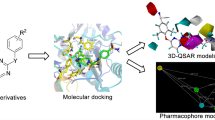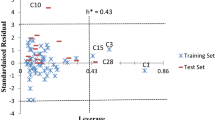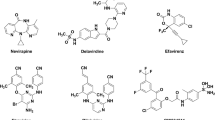Abstract
CoMFA and CoMSIA based 3D-QSAR of HIV-1 RT wild and mutant (K103, Y181C, and Y188L) inhibitory activities of 4-benzyl/benzoyl pyridin-2-ones followed by protein informatics of corresponding non-nucleoside inhibitors’ binding pockets from pdbs 2BAN, 3MED, 1JKH, and 2YNF were analysed to discover consensus features of the compounds for broad-spectrum activity. The CoMFA/CoMSIA models indicated that compounds with groups which lend steric-cum-electropositive fields in the vicinity of C5, hydrophobic field in the vicinity of C3 of pyridone region and steric field in aryl region produce broad-spectrum anti-HIV-1 RT activity. Also, a linker rendering electronegative field between pyridone and aryl moieties is common requirement for the activities. The protein informatics showed considerable alteration in residues 181 and 188 characteristics on mutation. Also, mutants’ isoelectric points shifted in acidic direction. The study offered fresh avenues for broad-spectrum anti-HIV-1 agents through designing new molecules seeded with groups satisfying common molecular fields and concerns of mutating residues.












Similar content being viewed by others
Abbreviations
- NNRTIs:
-
Non-nucleoside reverse transcriptase inhibitors
- QSAR:
-
Quantitative structure–activity relationship
- CoMFA:
-
Comparative molecular field analysis
- CoMSIA:
-
Comparative molecular similarity indices analysis
- NNIBP:
-
Non-nucleoside inhibitors binding pocket
References
Global report: UNAIDS report on the global AIDS epidemic (2012) http://www.unaids.org/en/media/unaids/contentassets/documents/epidemiology/2012/gr2012/20121120_UNAIDS_Global_Report_2012_en.pdf. Accessed on 9 April 2013
Imami N, Gotch F (2003) Twenty years of HIV-1 research: what the future holds. Nat Immunol 4:501
http://www.ncbi.nlm.nih.gov/genome/?term=txid11676[Organism:exp]
Clercq ED (1993) HIV-1specific RT inhibitors: highly selective inhibitors of human immunodeficiency virus type 1 that are specifically targeted at the viral reverse transcriptase. Med Res Rev 13:229–258
Spence RA, Kati WM, Anderson KS, Johnson KA (1995) Mechanism of inhibition of HIV-1 reverse transcriptase by nonnucleoside inhibitors. Science 267:988–993
Esnouf R, Ren J, Ross C, Jones Y, Stammers D, Stuart D (2006) Mechanism of inhibition of HIV-1 reverse transcriptase by non- nucleoside inhibitors. Nat Struct Biol 2:303–308
Figueiredo A, Moore Katie L, Mak J, Sluis-Cremer N, de Bethune MP, Tachedjian G (2006) Potent nonnucleoside reverse transcriptase inhibitors target HIV-1 Gag-Pol. PLoS Pathog 2:1051–1059
De Béthune MP (2010) Non-nucleoside reverse transcriptase inhibitors (NNRTIs), their discovery, development, and use in the treatment of HIV-1 infection: a review of the last 20 years (1989–2009). Antivir Res 85:75–90
Ren J, Stammers DK (2008) Structural basis for drug resistance mechanisms for non-nucleoside inhibitors of HIV reverse transcriptase. Virus Res 134:157–170
Petropoulos CJ, Parkin NT, Limoli KL, Lie YS, Wrin T, Huang W, Tian H, Smith D, Winslow GA, Capon DJ, Whitcomb JM (2000) A novel phenotypic drug susceptibility assay for human immunodeficiency virus type 1. Antimicrob Agents Chemother 44:920–928
Young SD, Britcher SF, Tran LO, Payne LS, Lumma WC, Lyle TA, Huff JR, Anderson PS, Olsen DB, Carroll SS (1995) L-743, 726 (DMP-266): a novel, highly potent nonnucleoside inhibitor of the human immunodeficiency virus type 1 reverse transcriptase. Antimicrob Agents Chemother 39:2602–2605
Byrnes VW, Sardana VV, Schleif WA, Condra JH, Waterbury JA, Wolfgang JA, Long WJ, Schneider CL, Schlabach AJ, Wolanski BS, Graham DJ, Gotlib L, Rhodes A, Titus DL, Roth E, Blahy OM, Quintero JC, Satszewski S, Emini EA (1993) Comprehensive mutant enzyme and viral variant assessment of human immunodeficiency virus type 1 reverse transcriptase resistance to nonnucleoside inhibitors. Antimicrob Agents Chemother 37:1576–1579
Benjahad A, Croisy M, Monneret C, Bisagni E, Mabire D, Coupa S, Poncelet A, Csoka I, Guillemont J, Meyer C, Andries K, Pauwels R, de Bthune MP, Himmel DM, Das K, Arnold E, Nguyen CH, Grierson David S (2005) 4-Benzyl and 4-Benzoyl-3- dimethylaminopyridin-2(1H)-ones: in vitro evaluation of new C-3-amino-substituted and C-5, 6-alkyl-substituted analogues against clinically important hiv mutant strains. J Med Chem 48:1948–1964
Guillemont J, Benjahad A, Oumouch S, Decrane L, Palandjian P, Vernier D, Queguiner L, Andries K, de Bethune MP, Hertogs K, Grierson David S, Nguyen CH (2009) Synthesis and biological evaluation of C-5 methyl substituted 4-arylthio and 4-aryloxy-3-iodopyridin-2(1H)-one type anti-HIV agents. J Med Chem 52:7473–7487
Benjahad A, Oumouch S, Guillemont J, Pasquir E, Mabire D, Andries K, Nguyen CH, Grierson DS (2006) Structure-activity relationship in the 3-iodo-4-phenoxypyridinone(IOPY) series: the nature of the C-3 substituent on anti-HIV activity. Bioorg Med Chem 17:712–716
Garg R, Gupta SP, Gao H, Babu MS, Debnath AK, Hansch C (1999) Comparative quantitative structure-activity relationship studies on anti-HIV drugs. Chem Rev 99:3525–3601
Pungpo P, Saparpakorn P, Wolschann P, Hannongbua S (2006) Computer-aided molecular design of highly potent HIV-1 RT inhibitors: 3D QSAR and molecular docking studies of efavirenz derivatives. SAR QSAR Environ Res 17:353–370
Carlsson J, Boukharta L, Aqvist J (2008) Combining docking, molecular dynamics and the linear interaction energy method to predict binding modes and affinities for non-nucleoside inhibitors to HIV-1 reverse transcriptase. J Med Chem 51:2648–2656
Prabhakar YS, Solomon VR, Rawal RK, Gupta MK, Katti SB (2004) CP-MLR/PLS directed structure-activity modeling of the HIV-1RT inhibitory activity of 2, 3-diaryl-1, 3-thiazolidin-4-ones. QSAR Comb Sci 23:234–244
Rawal RK, Prabhakar YS, Katti SB, Clercq ED (2005) 2-(Aryl)-3- furan-2-ylmethylthiazolidin-4-ones as selective HIV-RT inhibitors. Bioorg Med Chem 13:6771–6776
Rawal RK, Prabhakar YS, Katti SB (2007) Molecular surface features in modeling the HIV-1 RT inhibitory activity of 2-(2, 6-disubstituted phenyl)-3-(substituted pyrimidin-2-yl)-thiazolidin-4-ones. QSAR Comb Sci 26:398–406
Rawal RK, Tripathi R, Katti SB, Pannecouque C, Clercq ED (2008) Design and synthesis of 2-(2, 6-dibromo-phenyl)-3-heteroaryl-1, 3- thiazolidin-4-ones as anti-HIV agents. Eur J Med Chem 43:2800–2806
Murugesan V, Prabhakar YS, Katti SB (2009) CoMFA and CoMSIA studies on thiazolidin-4-one as anti-HIV-1 agents. J Mol Graph Model 27:735–743
Murugesan V, Tiwari VS, Saxena R, Tripathi R, Paranjape R, Kulkarni S, Makwana N, Suryawanshi R, Katti SB (2011) Lead optimization at C-2 and N-3 positions of thiazolidin-4-ones as HIV-1 non-nucleoside reverse transcriptase inhibitors. Bioorg Med Chem 19:6919–6926
Rawal RK, Murugesan V, Katti SB (2012) Structure-activity relationship studies on clinically relevant HIV-1 NNRTIs. Curr Med Chem 19:5364–5380
Cramer RD III, Patterson DE, Bunce JD (1988) Comparative molecular field analysis (CoMFA). 1. Effect of shape on binding of steroids to carrier proteins. J Am Chem Soc 110:5959–5967
Klebe G, Abraham U, Mietzner T (1994) Molecular similarity indices in a comparative analysis (COMSIA) of drug molecules to correlate and predict their biological activity. J Med Chem 37:4130–4146
Himmel DM, Das K, Clark AD Jr, Hughes SH, Benjahad A, Oumouch S, Guillemont J, Coupa S, Poncelet A, Csoka I, Meyer C, Andries K, Nguyen CH, Grierson DS, Arnold E (2005) Crystal structures for HIV-1 reverse transcriptase in complexes with three pyridinone derivatives: a new class of non-nucleoside inhibitors effective against a broad range of drug-resistant strains. J Med Chem 48:7582–7591
Lansdon EB, Brendza KM, Hung M, Wang R, Mukund S, Jin D, Birkus G, Kutty N, Liu X (2010) Crystal structures of HIV-1 reverse transcriptase with etravirine (TMC125) and rilpivirine (TMC278): implications for drug design. J Med Chem 53:4295–4299
Ren J, Nichols C, Bird L, Chamberlain P, Weaver K, Short S, Stuart DI, Stammers DK (2001) Structural mechanisms of drug resistance for mutations at codons 181 and 188 in HIV-1 reverse transcriptase and the improved resilience of second generation non-nucleoside inhibitors. J Mol Biol 312:795–805
Chong P, Sebahar P, Youngman M, Garrido D, Zhang H, Stewart EL, Nolte RT, Wang L, Ferris RG, Edelstein M, Weaver K, Mathis A, Peat A (2012) Rational design of potent non-nucleoside inhibitors of HIV-1 reverse transcriptase. J Med Chem 55:10601
Morris GM, Huey R, Lindstrom W, Sanner MF, Belew RK, Goodsell DS, Olson AJ (2009) AutoDock4 and AutoDockTools4: automated docking with selective receptor flexibility. J Comput Chem 30:2785–2789
Clark M, Cramer RD III, Van Opdenbosch N (1989) Opdenbosch. Validation of the general-purpose tripos 5.2 force field. J Comput Chem 10:982–1012
Barakat MT, Dean PM (1990) Molecular structure matching by simulated annealing. I. A comparison between different cooling schedules. J Comput Aided Mol Des 4:295–316
SYBYL, version 7.3 (2006) Tripos Associates, St. Louis, MO
Klebe G, Abraham U, Mietzner T (1994) Molecular similarity indices in a comparative analysis (COMSIA) of drug molecules to correlate and predict their biological activity. J Med Chem 37:4130–4146
Viswanadhan VN, Ghose AK, Revenkar GR, Robins RK (1989) Atomic physicochemical parameters for three dimensional structure directed quantitative structureactivity relationships. 4. Additional parameters for hydrophobic and dispersive interactions and their application for an automated superposition of certain naturally occurring antibiotics. J Chem Inf Comput Sci 29:163–172
Klebe G (1994) The use of composite crystal-field environments in molecular recognition and the de novo design of protein ligands. J Mol Biol 237:212–235
Stahle L, Wold S (1988) 6 multivariate data analysis and experimental design in biomedical research. Prog Med Chem 25:291–338
Thompson JD, Higgins DG, Gibson TJ (1994) CLUSTAL W: improving the sensitivity of progressive multiple sequence alignment through sequence weighting, position-specific gap penalties and weight matrix choice. Nucleic Acids Res 22:4673–4680
Hall TA (1999) BioEdit: a user-friendly biological sequence alignment editor and analysis program for Windows 95/98/NT. Nucleic Acids Symp Ser 41:95–98
MOE: The Molecular Operating Environment from Chemical Computing Group Inc., 1255 University St., Suite 1600, Montreal, Quebec, Canada H3B 3X3. http://www.chemcomp.com
Ng PC, Henikoff S (2003) SIFT: predicting amino acid changes that affect protein function. Nucleic Acids Res 31:3812–3814
Mi H, Guo N, Kejariwal A, Thomas PD (2007) PANTHER version 6: protein sequence and function evolution data with expanded representation of biological pathways. Nucleic Acids Res 35(Database issue):D247–D252
Capriotti E, Fariselli P, Casadio R (2005) I-mutant 2.0: predicting stability changes upon mutation from the protein sequence or structure. Nucleic Acids Res 33(Web Server issue):306–310
Parthiban V, Gromiha MM, Schomburg D (2006) CUPSAT: prediction of protein stability upon point mutations. Nucleic Acids Res 34:239–242
Willard L, Ranjan A, Zhang H, Monzavi H, Boyko RF, Sykes BD, Wishart DS (2003) VADAR: a web server for quantitative evaluation of protein structure quality. Nucleic Acids Res 31:3316–3319
Kyte J, Doolittle RF (1982) A simple method for displaying the hydropathic character of a protein. J Mol Biol 157:105–132
Sillero A, Maldonado A (2006) Isoelectric point determination of proteins and othermacromolecules: oscillating method. Comput Biol Med 36:157–166
Calculation of protein isoelectric point. http://isoelectric.ovh.org/
Krenn BM, Egorov A, Romanovskaya-Romanko E, Wolschek M, Nakowitsch S, Ruthsatz T, Kiefmann B, Morokutti A, Humer J, Geiler J, Cinatl J, Michaelis M, Wressnigg N, Sturlan S, Ferko B, Batishchev OV, Indenbom AV, Zhu R, Kastner M, Hinterdorfer P, Kiselev O, Muster T, Romanova J (2011) Single HA2 mutation increases the infectivity and immunogenicity of a live attenuated H5N1 intranasal influenza vaccine candidate lacking NS1. PLoS ONE 6:e18577
Ren J, Milton J, Weaver KL, Short SA, Stuart DI, Stammers DK (2000) Structural basis for the resilience of Efavirenz (DMP-266) to drug resistance mutations in HIV-1 reverse transcriptase. Structure 8:1089–1094
Das K, Bauman JD, Clark AD Jr, Frenkel YV, Lewi PJ, Shatkin AJ, Hughes SH, Arnold E (2008) High-resolution structures of HIV-1 reverse transcriptase/TMC278 complexes: strategic flexibility explains potency against resistance mutations. PNAS 105:1466–1471
Acknowledgments
Authors thank Dr. Shreekant Deshpande and V. Murugesan for helpful discussion and Ms. Neelam Mishra for technical help. Two of the authors, UD and SV, thank CSIR and DST, New Delhi, respectively, for senior research fellowships. CDRI Communication No.8492
Author information
Authors and Affiliations
Corresponding author
Electronic supplementary material
Below is the link to the electronic supplementary material.
Rights and permissions
About this article
Cite this article
Debnath, U., Verma, S., Jain, S. et al. Pyridones as NNRTIs against HIV-1 mutants: 3D-QSAR and protein informatics. J Comput Aided Mol Des 27, 637–654 (2013). https://doi.org/10.1007/s10822-013-9667-1
Received:
Accepted:
Published:
Issue Date:
DOI: https://doi.org/10.1007/s10822-013-9667-1




